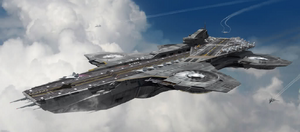| Deimos-class Helicarrier | |
|---|---|
|
| |
| Role | Aerial Aircraft Carrier/Command Platform |
| National origin | |
| Manufacturer | Manus Heavy Industries |
| First flight | 17 October 2004 |
| Introduction | 22 March 2008 |
| Status | Active |
| Primary user | Pravus International |
| Number built | 7 planned 4 active 2 under construction |
| Program cost | $338.4 billion |
| Unit cost | $8.21 billion |
The Deimos-class Helicarriers are a class of three VTOL aircraft carriers designed and produced by Manus Heavy Industries for usage by their parent company, Pravus International. Named after Deimos from Greek mythology, who was te son of Ares, and personification of fear and terror. The Deimos-class airships are used by Pravus' corporate security forces to project the powerful corporation's power across the globe; a task aided by the fact that they are powered fusion energy, allowing for a near-infinite source of power and allowing for endless airtime. Only the need to restock on supplies and rotate crew and personnel effect the helicarrier's ability to remain in flight indefinitely.
History[]
The Helicarrier was initially designed to serve as a large-scale cargo hauler that could move several hundred megatons of material goods and equipment from region to next safely and speedily. However, the Pravus directors chose to devote the resources on a large aerial hauler toward that of a military vehicle after the corporation's interests in military-style diplomacy began to supercede that of expensive cargo transportation. The helicarrier was quickly redesigned from a heavy carrier to that of a heavy personnel transport. It was designed to hold a brigade-sized force or a division-sized drone force, as well as several dozen aircraft for quick attack forces.
Pravus' CSO Stephan Nash was unimpressed with the conversion, angered that the potential of the craft to transport food and medical aid to poor nations was instead scrapped to increase the corporation's military potential. He protested the plan, and was temporarily replaced by the head of Manus Heavy Industries, Silvano Archuleta, as the head of the project in 2003. Under Archuleta, the project was fast-tracked to complete the project by 2004 after news of a rebellion in Haiti circulated in the corporation. Rushing the first helicarrier, the PCV Fomalhaut was completed in October of 2004 on time, though with many of the planned features uninstalled.
Despite the Fomalhaut flying with a skeleton crew to conserve the resources the corporation failed to install in their desire to rush the project, Julius Marshall and Abigail Townsend was impressed with the end result, using their combined shares to outvote Nash and his supporters. Over the next four years, the PCV Kismet and PCV Galvan were completed and put into service with the Pravus Combat Legions in 2008, with a fully-fitted PCV Fomalhaut as the leading ship of the aerofleet. The first deployment of the Demios-class helicarriers was to Israel where the PCV Galvan was to head counter-insurgency operations against pro-Israeli guerillas after the 2007 Pravus–Israeli War.
Design[]
The Deimos-class helicarrier is built with four super-heavy turbo fans which provide lift and stability for the craft, and several large jet engines for thrust. There are runways on the helicarrier, one long for standard catapult-launched aircaft, and shorter one for S/VTOL and VTOL aircraft such as the Pravus QF-4 Manhunter. The longer runway can cleared to hold additional VTOL aircraft, which has often been the case for Pravus-owned versions of the helicarrier. All energy requirements are fulfilled by a single fusion power generator built by Makamashi, with a secondary backup generator which only able to come online when the power generator has failed.

